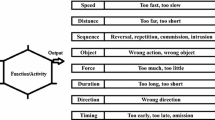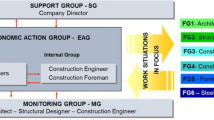Abstract
The Traditional tools for occupational risk assessment like preliminary hazard analysis, hazard checklists, fault trees are based on the isolation of hazard activities from the entire process and the development of specific measures to avoid or minimize the occupational risk. This strategy makes the results of such evaluations distant from real situations. The Functional Resonance Analysis Method (FRAM) defines a systemic framework to model complex systems based on combinations of function variabilities during normal work. FRAM which aims to describe how function couplings may be combined in such a way that variability of performance, rather than failure or poor functioning, creates an occupational risk. In order to minimize the subjectivity associated with the qualitative analyses of the functions performed by experts’ judgments required by FRAM, a multi-criteria decision-support method was added. Analytic hierarchy process (AHP) are used in situations involving multiple objectives, various decision-makers, and the simultaneous treatment of complex issues. In this sense, this research contributes to the evolution of FRAM, by proposing the application of the AHP, to investigate the relative importance of the criteria and alternatives for the identification of phenotypes of performance variability, as well as the aggregation of variability. The results of this study demonstrate that this combined technique FRAM-AHP can be used to assess and quantify the performance variabilities that may lead to occupational or environmental accidents and provide new recommendations about how work processes should function, minimizing production losses, incidents and accidents.
Access this chapter
Tax calculation will be finalised at checkout
Purchases are for personal use only
Similar content being viewed by others
References
Boileau, P.: Sustainability and prevention in occupational health and safety. Ind. Health 54(4), 293–295 (2016)
Rasmussen, J.: Risk management in a dynamic society: a modelling problem. Saf. Sci. 27(2), 183–213 (1997)
Taubitz, M.: How safety fits with sustainability. Occup. Health Saf. 79(9), 18 (2010)
Carvalho, P.: The use of functional resonance analysis method (FRAM) in a mid-air collision to understand some characteristics of the air traffic management system. Reliab. Eng. Syst. Saf. 96(11), 1482–1498 (2011)
Shiralia, G., Motamedzadeb, M., Mohammadfama, I., Ebrahimipourc, V., Moghimbeigid, A.: Challenges in building resilience engineering (RE) and adaptive capacity: a field study in a chemical plant. Process Saf. Environ. Prot. 90(2), 83–90 (2012)
Simon, A., David, B., Susanne, T.: Advantages for risk assessment: evaluating learnings from question sets inspired by the FRAM and the risk matrix in a manufacturing environment. Saf. Sci. 89(1), 180–189 (2016)
Saurin, T.: The FRAM as a tool for modelling variability propagation in lean construction. In: 24th Annual Conference of the International Group for Lean Construction Proceedings on Proceedings, Sect. 11 pp. 3–12. IGLC-24, Boston, MA, USA (2016)
Hollnagel, E.: FRAM—The Functional Resonance Analysis Methods: Modeling Complex Socio-technical Systems, 1st edn. Ashgate, Aldershot, UK (2012)
Fung, I., Tam, V., Lo, T., Lu, L.: Develo** a risk assessment model for construction safety. Int. J. Project Manage. 28(6), 593–600 (2010)
Hollnagel, E.: Barriers and Accident Prevention, 1st edn. Ashgate, Aldershot, UK (2004)
Steen, R., Aven, T.: A risk perspective suitable for resilience engineering. Saf. Sci. 49(1), 292–297 (2011)
Mitropoulos, P., Namboodiri, M.: New method for measuring the safety risk of construction activities: task demand assessment. J. Constr. Eng. Manag. 137(1), 30–38 (2011)
Rosa, L., França, J., Haddad, A., Carvalho, P.: A resilience engineering approach for sustainable safety in green construction. J. Sustain. Dev. Energy, Water Environ. Syst. 5(4), 480–495 (2017)
Saaty, T.: The Analytic Hierarchy Process: Planning, Priority Setting, Resource Allocation, 1st edn. McGraw-Hill, New York, USA (1980)
Costa, H.: Multicriteria Decision Aid—AHP (in Portugese), 1st edn. Abepro, Rio de Janeiro, Brasil (2006)
Hollnagel, E., Woods, D., Levenson, N.: Resilience Engineering: Concepts E precepts. Ashgate, Aldershot (2006)
Badri, A., Nadeau, S., Gbodossou, A.: Proposal of a risk-factor-based analytical approach for integrating occupational health and safety into project risk evaluation. Accid. Anal. Prev. 48, 223–234 (2012)
Pereira, R., Morgado, C., Luquetti dos Santos, I., Victor, P.: Safety analysis of the deepwater horizon blowout based on the functional resonance analysis model (FRAM). In: Proceedings on the 5th International Conference on Applied Human Factors and Ergonomics—AHFE, pp. 327–337, Kraków, Poland (2014)
Carvalho, P., Gomes, J., Huber, J., Vidal, M.: Normal people working in normal organizations with normal equipment: system safety and cognition in a mid-air collision. Appl. Ergon. 40(3), 25–340 (2009)
Grecco, C., Vidal, M., Cosenza, C., Luquetti dos Santos, I., Carvalho, P.: Safety culture assessment: a fuzzy model for improving safety performance in a radioactive installation. Prog. Nucl. Energy 70, 71–83 (2014)
Dekker, S., Cilliers, P., Hofmeyr, J.: The complexity of failure: implications of complexity theory for safety investigations. Saf. Sci. 49(6), 939–945 (2011)
Aneziris, O., Topali, N., Papazoglou, I.: Occupational risk of building construction. Reliab. Eng. Syst. Saf. 105, 36–46 (2012)
Ayoub, N., Musharavati, F., Pokharel, S., Gabbar, H.A.: Risk based life cycle assessment conceptual framework for energy supply systems in large buildings. J. Clean. Prod. 107, 291–309 (2015)
Gurcanli, G., Mungen, U.: An occupational safety risk analysis method at construction sites using fuzzy sets. Int. J. Ind. Ergon. 39(2), 371–387 (2009)
Sovacool, B.K., Andersen, R., Sorensen, S., Sorensen, K., Tienda, V., Vainorius, A., Schirach, O.M., Bjørn-Thygesen, F.: Balancing safety with sustainability: assessing the risk of accidents for modern low-carbon energy systems. J. Clean. Prod. 112(5), 3952–3965 (2016)
Aguilera, M., Fonseca, B., Ferris, T., Vidal, M., Carvalho, P.: Modelling performance variabilities in oil spill response to improve system resilience. J. Loss Prev. Process Ind. 41, 18–30 (2016)
Al, R., Andrea, S., Jamie, K., Wendy, G., Janet, A., Leigh, D., Lorna, M.: A systems approach using the functional resonance analysis method to support fluoride varnish application children attending general dental practice. Appl. Ergon. 68, 294–303 (2018)
Fabio, P., Tarcisio, S.: Applying FRAM for problem solving in complex sociotechnical systems: case study of a hospital unit. Revista Produção Online 19(1), 102–128 (2019)
Saurin, T., Junior, G.: Evaluation and improvement of a method for assessing HSMS from the resilience engineering perspective: a case study of an electricity distributor. Safaty Sci. 49, 355–368 (2011)
Gomes, L., Araya, M., Carignano, C.: Decision-making in Complex Scenarios: Introduction to Discrete Methods of Multicriteria Decision (in Portugese). Pioneira, São Paulo, Brasil (2004)
Ali, H., Nsairat, S.: Develo** a green building assessment tool for develo** countries: case of Jordan. Build. Environ. 44(5), 1053–1064 (2008)
Tiwari, D., Loof, R., Paudyal, G.: Environmental-economic decision-making in Lowland irrigated Agriculture using Multi-criteria analysis Techniques. Agric. Syst. 60(2), 99–112 (1999)
Rosa, L., Haddad, A., Carvalho, P.: Assessing risk in sustainable construction using the functional resonance analysis method (FRAM). Cogn. Technol. Work. 7(4), 559–573 (2015)
Author information
Authors and Affiliations
Corresponding author
Editor information
Editors and Affiliations
Rights and permissions
Copyright information
© 2020 Springer Nature Switzerland AG
About this chapter
Cite this chapter
Rosa, L.V., Carvalho, P.V.R., Haddad, A.N. (2020). FRAM-AHP: A Resilience Engineering Approach for Sustainable Prevention. In: Arezes, P., et al. Occupational and Environmental Safety and Health II. Studies in Systems, Decision and Control, vol 277. Springer, Cham. https://doi.org/10.1007/978-3-030-41486-3_14
Download citation
DOI: https://doi.org/10.1007/978-3-030-41486-3_14
Published:
Publisher Name: Springer, Cham
Print ISBN: 978-3-030-41485-6
Online ISBN: 978-3-030-41486-3
eBook Packages: EngineeringEngineering (R0)




